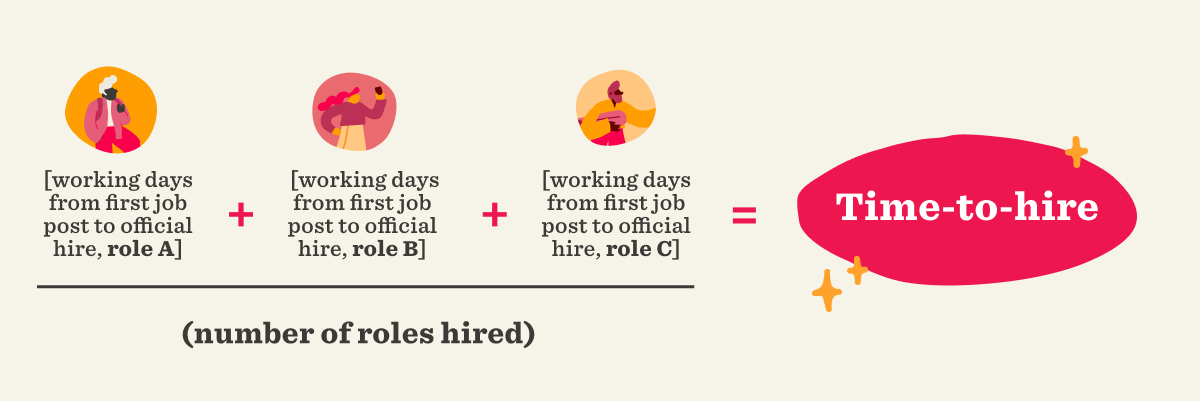Attracting and retaining top talent is a key focus for HR leaders, boards of directors, and C-suite executives. Reducing your time-to-fill and time-to-hire helps keep teams productive and projects moving forward smoothly. These metrics reveal ways to streamline workflows, improve the candidate experience, and secure the best talent to drive your business forward. But what’s the difference between them?
Time-to-hire and time-to-fill refer to two areas of recruitment and retention that are within your control. Because of this, they’re invaluable metrics. And while both vary from company to company and industry to industry, they can give you essential insights into how you might improve and optimize your recruitment processes. This can help improve the candidate experience—and ensure you’re able to hire the talent you want within a reasonable timeframe.
This article will take a deep dive into:
- The crucial differences between time-to-fill vs. time-to-hire
- How to measure time-to-fill and time-to-hire
- How these metrics will help you tighten up your recruitment
What is time-to-hire?
Time-to-hire describes the amount of time between a candidate applying for a job and that same candidate accepting an offer. This metric captures the hiring team’s efficiency in identifying and moving the best candidate through the pipeline. A shorter time-to-hire demonstrates a streamlined process and keeps candidates engaged, while delays at this stage can lead to losing top talent to other opportunities.
Why is time-to-hire an important metric?
Time-to-hire is an important HR metric for two reasons. First, any delays during this crucial period can cause top candidates to drop out of the funnel. Delays in the hiring process can be frustrating and may encourage candidates to drop out, especially if a competitor has a faster time-to-hire.
Second, long hiring times can create negative experiences for prospective applicants and recruiters, which can impact your company’s image and reputation, making recruiting high-quality, qualified candidates more difficult.
Recruiting costs are significant. Cutting down the time-to-hire with a more streamlined interview and test process can help take the pressure off HR and hiring managers and keep the process more budget-friendly. A high time-to-hire score can mean that there’s a problem in your recruitment process, such as:
- Jobs aren’t being posted in enough or the right channels
- Recruiters are overwhelmed by the number of applicants or open roles and can’t get back to recruits in a reasonable time frame
- Hiring managers aren’t available to review tests or conduct interviews
- Hiring processes are too high-touch or complicated
How do you calculate time-to-hire?
Time-to-hire can be measured organization-wide or by team. To calculate time-to-hire, divide the total of working days spent hiring candidates by the roles hired. It will look like:
([working days from first job post to official hire, role A] + [working days from first job post to official hire, role B] + [working days from first job post to official hire, role C] + …) / (number of roles hired) = time-to-hire

To calculate time-to-hire for your organization, use data for organization-wide hiring. For team or department-specific results, use data from those specific groups.
Time-to-hire benchmark
The average time-to-hire benchmark varies depending on your industry. For example, time-to-hire in engineering industries can often be more than 60 days. On the other hand, the average overall time-to-hire sits at 44 days.
Benchmarking your company’s average time-to-hire helps you see if there’s room to optimize your recruitment process and make it more efficient. This could mean refining your job descriptions or setting up an employee referral program to attract top talent.
A short time-to-hire indicates an efficient recruitment process, from receipt of the first application to signed contracts. It puts companies in a solid position to hire the best candidates as soon as they apply.
What is a good time-to-hire benchmark?
The average time-to-hire benchmark hovers around 44 days for most companies. But you can aim to fill positions faster than this to give your team the best shot at landing top candidates. Contact potential candidates quickly and keep them engaged throughout the hiring process to keep this number down.
How to reduce time-to-hire
Reducing your time-to-hire helps you secure high-demand team members. Implement these actionable steps to improve your hiring experience:
1. Build a clear structure for your hiring process
Document your hiring process from start to finish, detailing every step candidates take and how long each one should take. For example, map what happens from the application to the first interview and from the first interview to the second.
Then, identify any bottlenecks. If scheduling interviews takes days, consider automating this task to speed up outreach. If you learn that candidates wait too long for feedback after interviews, set up reminders or assign a point person to follow up promptly.
2. Create a talent pipeline
Effective sourcing can significantly impact the entire process. Build a pool of pre-screened candidates who match your most frequent hiring needs. Instead of waiting for applications, reach out to this group about new opportunities to save time on advertising and vetting.
Stay in touch with strong candidates from past recruitment cycles to keep your pipeline ready for future openings and expand your pool with new graduates and underrepresented groups to ensure a diverse and well-rounded candidate base.
3. Prepare valuable resources to attract candidates
Give candidates helpful content that highlights your workplace and keeps your company top of mind. Share resources like guides, checklists, and blogs that showcase your culture, values, and industry expertise. These materials can engage prospective applicants and demonstrate how your company supports professional growth.
4. Integrate HR tech to streamline your application, interview, and hiring processes
Invest in HR tech like an applicant tracking system (ATS) or recruitment management system (RMS). An ATS automates tasks like posting jobs, tracking interviews, and sorting applications to save time at every step. An RMS usually offers all the administrative automation of an ATS plus candidate relationship management features. While an ATS can satisfy the hiring needs of small businesses, an RMS includes full services, so it may have more to offer for larger organizations.
What is time-to-fill?
The difference between time-to-hire and time-to-fill is small but meaningful. Time-to-hire measures the efficiency of your organizational hiring process and starts at the date of publication of the first job ad. Time-to-fill begins when a hiring manager or department head submits an official job request to HR, signaling the need to fill a position. This marks the start of the recruitment process, even before the role is advertised, encompassing everything from job description creation to sourcing candidates.
Why is time-to-fill an important metric?
Every day a role stays vacant, projects slow down, work piles up, and productivity drops. Tracking time-to-fill helps HR leaders:
- Ensure project deadlines stay on schedule
- Pinpoint delays in sourcing, approvals, or offers
- Forecast how long it will take to fill critical roles
How do you calculate time-to-fill?
Similar to time-to-hire, time-to-fill can be measured organization-wide or per team. To calculate time-to-fill, divide the total number of working days between the submission of a job request and the official hire, then divide by the number of roles hired. It will look like:
([working days… role A] + [working days… role B] + [working days… role C] + …) / (number of roles filled) = time-to-fill

Time-to-fill benchmark
As with time-to-hire, the average time-to-fill differs across industries. When determining optimal time-to-fill and time-to-hire lengths, consider the diverse skill sets and levels of complexity roles required across various industries and more senior- versus junior-level positions.
What’s a good benchmark for time-to-fill?
Ensuring your time-to-fill is on par with your industry average is good business practice. The average time-to-fill hovers around 44 days for most industries.
How to reduce time-to-fill
Making your recruitment process and candidate experience as efficient and effective as possible helps boost the employee experience and your employer brand. Implement these actionable steps to improve your candidate experience:
1. Standardize job request and approval workflows
Streamline internal processes by establishing clear workflows for opening new roles and approving job requests. Use templates and HR automation tools to reduce delays when gaining approvals from department heads or HR leaders for new roles, budgets, or listings.
Pre-approved job description templates save time by eliminating the need to create new descriptions for every role. They ensure consistency across postings while making it easy to fill in role-specific details quickly. They also reduce delays caused by excessive edits or approval cycles, allowing job ads to go live faster.
<<Create an attractive careers page with our free job description template.>>
2. Clarify and communicate your company brand
Actively manage your employer brand to show candidates why your company is a great place to work. Share stories and testimonials from current team members through videos, social media, and your career page to attract candidates who align with your values. A well-designed careers page reduces drop-offs and increases applications from top talent.
You can also conduct audits to see how people perceive your organization and address feedback to strengthen your brand and candidate appeal.
3. Hire internally
Internal hiring eliminates the need to spend time sourcing or advertising, which significantly reduces the time to fill. It speeds up recruitment by tapping into a talent pool already familiar with your organization. These candidates often require fewer interviews and minimal onboarding since they already understand company systems and culture.
4. Use employee referral programs
If you’re hiring externally, leverage internal referrals to hire qualified candidates faster and with lower recruitment costs. You can offer enticing incentives like cash bonuses or gift cards to encourage participation. Promote your program during onboarding and through regular reminders so people continue to refer talented friends and colleagues.
5. Track and improve job post metrics
Gather feedback on which aspects of previous job listings attracted qualified applicants. Analyze data from your ATS to identify trends—such as keywords or role-specific details that led to more applications. If possible, ask recent hires for feedback on what drew them to the posting or work with survey hiring managers to understand which listings brought in candidates that closely matched the role’s needs.
Look for patterns, like clarity in responsibilities, concise descriptions of skills, or appealing language about company culture. Use the information to improve the listing based on your real-world successes.
Time-to-fill vs. time-to-hire
HR leaders measure both time-to-hire and time-to-fill to track recruitment—but they differ in key aspects. While time-to-hire focuses on the efficiency of the selection process, time-to-fill encompasses the entire recruitment timeline.
Similarities between time-to-fill and time-to-hire
- Measure time within the hiring process
- Provide insights into recruitment efficiency
- Impact the speed at which roles are filled
- Help identify delays like long response times or slow decision-making
- Influence the candidate’s experience
Differences between time-to-fill and time-to-hire
- Time-to-hire starts when the first candidate applies
- Time-to-fill begins before that when leaders decide to open a role
- Time-to-hire focuses on stages like screening, interviewing, and accepting offers
- Time-to-fill includes additional steps like job approval and posting
- Time-to-fill lasts longer since it includes both the candidate’s journey and the company’s preparation phase
How to decide whether to prioritize time-to-hire or time-to-fill
Choosing whether to focus on the time-to-hire or time-to-fill metric depends on your company’s goals and challenges. Time-to-fill provides a better picture of your entire recruitment process, from job approval to onboarding. This metric helps if you aim to improve overall hiring efficiency or reduce the cost of vacancies.
In contrast, prioritize time-to-hire if you need to refine specific recruitment stages to move people through the pipeline faster. For example, companies looking to improve response times or stop losing high-demand candidates may find time-to-hire more actionable.
Ultimately, your choice should align with your organization’s needs, whether that’s reducing vacancy costs, speeding up candidate decisions, or enhancing the overall hiring experience.
The importance of time-to-hire and time-to-fill in modern HR strategy
Time-to-hire and time-to-fill are invaluable metrics that highlight aspects of the recruitment process that are within your control. Both metrics vary from company to company and depend on many factors—from industry and company size to labor market regulations and job requirements.
Time-to-hire and time-to-fill metrics can help companies optimize their recruitment processes and build an agile strategy that can help you hire more qualified talent faster.
Time-to-fill vs. time-to-hire FAQs
Why measure time-to-hire or time-to-fill?
These metrics can reveal delays in your hiring process. If candidates spend too much time waiting for interviews, it may signal to streamline scheduling or improve communication. Or, if job postings remain live for extended periods without attracting qualified applicants, it may indicate a need to revise the job description or adjust sourcing strategies. Tracking these metrics ultimately helps fill open roles faster to keep the business moving forward.
Recommended For Further Reading
What are some common factors that can affect time-to-fill and time-to-hire?
Factors like slow approvals, lengthy interviews, or low-quality applications can delay hiring. Unclear job descriptions may also attract unqualified candidates and force recruiters to spend extra time filtering through applications. Internal coordination, such as delays in feedback from hiring managers, can also stretch the timeline unnecessarily.
Is time-to-hire or time-to-fill a more important metric?
Several factors influence hiring timelines, including your industry, company size, and the resources available to your HR team. Senior-level or specialized roles often take longer to fill, as do periods when multiple roles are open at once. The complexity of the role, the number of qualified candidates, and how quickly feedback is shared also play a role in determining how long the process takes.


